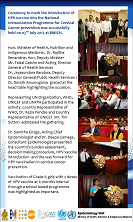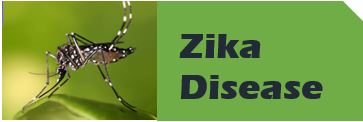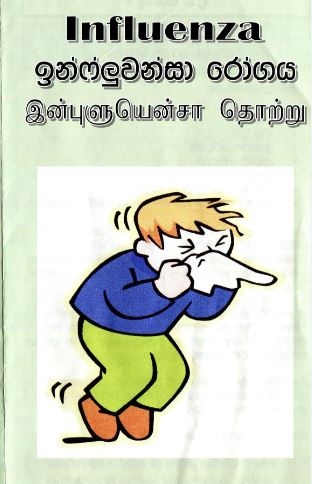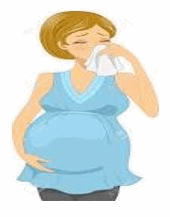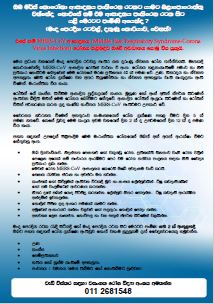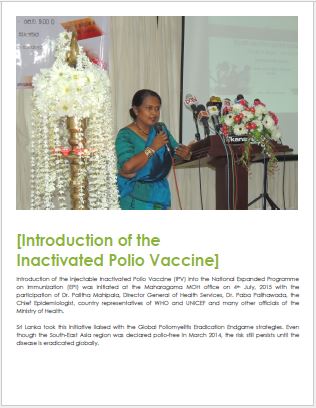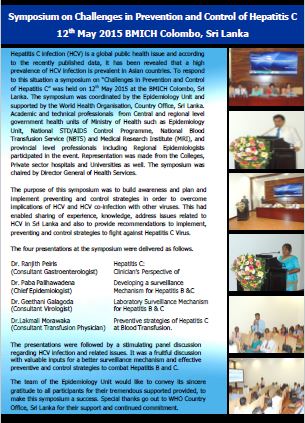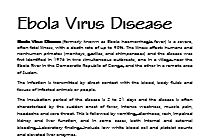
- About Us
-
Immunization
- Immunization Schedule
- Cold Chain
- Publications
- Reporting Forms
- Circulars & Letters
- Important Link
- EPI Review Formats
- WEBIIS Application
-
Disease Surveillance
- List of Notifiable Diseases
- Trends
- WER
- QEB
- Investigation Forms
- AEB
- COVID-19 Situation Report
- Disease Information
- Downloads
- Image Gallery
National Immunization Programme of Sri Lanka
In the year 1798, Edward Jenner first demonstrated that vaccination offered protection against smallpox. He used cowpox (poxvirus bovis) for the immunization of man against the smallpox virus (poxvirus varialae). For the last 200 years, the use of vaccines has continued to reduce the burden of many bacterial and viral diseases.
Smallpox itself has been eradicated, and poliomyelitis in the verge of eradication. In Sri Lanka, the last case of virologically confirmed poliomyelitis patient was reported in 1993.
In Sri Lanka, the introduction of routine immunization has generally reduced the incidence of several vaccine preventable diseases. Similar success in disease reduction has been demonstrated by immunization programmes in many other countries. The World Health Organization’s (WHO) Expanded Programme on Immunization (EPI), with assistance from the United Nation’s Children’s Fund (UNICEF) and other donors, has made great strides in extending these benefits to developing countries. Immunizations permitted the global eradication of smallpox, and may do the same for poliomyelitis and some other diseases.
Immunizing a child not only protects that child but also other children by increasing the general level of immunity and minimising the spread of infection.
History of Immunization in Sri Lanka
The history of immunization in Sri Lanka goes back to the 19th century. The law relating to compulsory vaccination (against smallpox) is referred to in the Vaccination Ordinance of 1886.
The Expanded Programme on Immunization (EPI) established in 1978, has continued to make excellent progress over the past two decades, most notably in terms of achieving high immunization coverage and disease control. The milestones of immunization in Sri Lanka are given below.
|
1886 |
Vaccination against smallpox introduced under the Vaccination Ordinance |
|
1949 |
BCG Vaccination introduced against tuberculosis |
|
1961 |
“Triple” vaccination introduced against diphtheria, whooping cough and tetanus |
|
1962 |
Oral polio vaccine introduced |
|
1963 |
BCG vaccination of newborn introduced |
|
1969 |
Tetanus Toxoid administration to pregnant mothers introduced |
|
1978 |
Launching of the Expanded Programme on Immunization |
|
1984 |
Measles vaccination introduced |
|
1991 |
Revision of Tetanus Toxoid schedule |
|
1995 |
First National Immunization Days conducted. |
|
1996 |
Introduction of Rubella vaccine |
|
2001 |
Introduction of revised National Immunization Schedule with MR and ATd |
|
2003 |
Introduction of Hepatitis B Vaccine on phase basis |
|
2008 |
Introduction of Hib containing Pentavalent vaccine |
Immunization Schedule
With the commencement of the EPI Programme in 1978 focus was to control childhood T.B., tetanus, whooping cough, diphtheria, polio and neo-natal tetanus. In 1988, the focus shifted to disease elimination. In 1991, a fifth dose of OPV was introduced at school entry to facilitate the polio eradication process. Rubella, Hepatitis B and Hib containing Pentavalent vaccines introduced to the programme gradually over the years. The present EPI vaccination schedule is given in annex below. JE vaccine was introduced to high-risk areas in 1987. Primary Immunization against JE consists of 3 doses at an interval of 2 – 4 weeks between the first and second doses and one year between the second and third. A booster dose is given every 4 years after the primary immunization. JE immunization is offered children below the age of ten years living in identified high-risk areas.
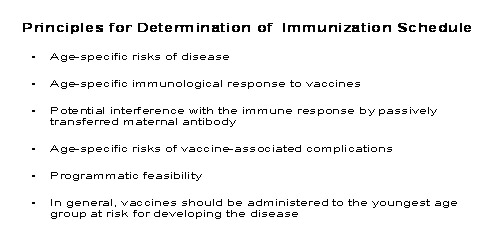
Objectives of the National Immunization Programme
- Eradication of poliomyelitis
- Elimination of neonatal tetanus, diphtheria, measles and rubella
- Reduction of morbidity and mortality due to whooping cough prevention of outbreaks
- Reduction of morbidity and mortality due to hepatitis B
- Reduction of morbidity and mortality due to Japanese Encephalitis
- Reduction of morbidity and mortality due to Haemophilias influence B disease
To achieve the above objectives, immunity has to be create in population against the specific organisms causing above diseases by administering potent vaccines in correct dosage using correct technique and according to the national immunization schedule.
 |
Read more about National Immunization Programme of Sri Lanka |
What's New
|
COVID - 19 Daily Situation Report
|
|
COVID - 19 Situation Sri Lanka - Epidemiological Summary |
|
COVID - 19 Vaccination Summary
|
|
|
|
COVID-19 Death Analysis - (5-18) Age group |
| Preparation Pfizer Vaccine |
| Provisional Clinical Guidelines on COVID-19 |
| COVID - 19 Hospital Preparedness Final |
| To minimize COVID - 19 in the country |
|
SL - TL 2019 |
| Timor Leste - Sri Lanka twining agreement thematic area 3 - 2019 |
|
CKDu Study 2017 |
| Epid / WHO / NSF CKDu Study 2017 |
| Health and Emergency Response - Flood and landslide 2018 |
|
Dengue
|
| Advice's for patients with Dengue Fever who are on ambulatory care ( Sinhala / Tamil / English) |
| Printable versions (Sinhala/Tamil/English) |
| Triage of fever patients with suspected dengue and criteria for admission |
Timor Lestre - Sri Lanka twining agreement
Health and Emergency Response - Flood and landslide 2018 New
Introduction of Human Papillomavirus (HPV) Vaccine into the National Immunization Programme ![]()
-----------------------------------------

Advice's for patients with Dengue Fever who are on ambulatory care ( Sinhala / Tamil / English )
Printable versions ( Sinhala / Tamil / English )
Triage of fever patients with suspected dengue and criteria for admission
-----------------------------------------

Disease Surveillance in Flood Affected Areas
1. Public health measures to be adopted in the event of floods.
2. Health messages for public.
-----------------------------------------
Zika Leaflet ( Sinhala/English )
Immunization coverage assessment survey
Ebola Preparedness – Assessment in Sri Lanka
Polio Eradication Endgame Plan
Introduction of the Inactivated Polio Vaccine
Symposium on Challenges in Prevention and Control of Hepatitis C
Working guideline for the management of patients having Ebola Virus Disease (EVD)
Diagnosis of Ebola virus disease (EVD)
Haematological investigations of Ebola Virus disease (EVD) suspected patients
Before conducting any haematological investigations on suspected Ebola Virus disease (EVD) patients
Please contact,
- Epidemiology unit – 0112 695112, 0112 681548
- Dr. Sunethra Gunasena (Consultant virologist ) Medical Research Institute(MRI) Colombo

Routine H399 (Weekly Return of Communicable Diseases) based disease surveillance system has been the driving hub for Sri Lankan...

A report has been received on 22nd March 2011 by the Epidemiology Unit of the Ministry of Health from the Regional Epidemiologist...
 |
|
Developed in Association with  |












